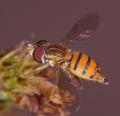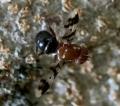Diptera.info :: Identification queries :: Diptera (adults)
Who is here? 1 guest(s)
|
Tabanidae
|
|
| Susan R Walter |
Posted on 23-02-2007 23:20
|
|
Member Location: Touraine du Sud, central France Posts: 1802 Joined: 14.01.06 |
My father sent me this image of a Tabanidae taken in Eucla, Western Australia. It has quite a hemispherical head and the eyes are straight across at the back, the body is quite wide and parallel sided, greyish with yellow bands on the apical edge of each tergite, the wings are clear and there is a spur on R4. This made me wonder about Atylotus, but the Bishops Museum catalogue does not list this genus for Australia. In addition, although the antennae are wholly orange except for a bit of darkening on the flagellomere tip, they are very long and the eyes are a very bright green, which does not seem to fit the usual descriptions of Atylotus. I think the eyes might be very sparsely hairy and there is perhaps one dark eyeband, but the photo is not really at the right angle to be certain. Does anyone have any thoughts? Susan R Walter attached the following image:  [185.13Kb] Susan |
| Tony T |
Posted on 24-02-2007 13:59
|
|
Member Location: New Brunswick, Canada Posts: 664 Joined: 08.02.07 |
If this specimen is a member of the SF: Tabaninae, Tribe Tabanini (which seems reasonable), then Tabanus is the only genus in Australia. Mackerras (1971) lists only 2 species from south Australia (Eucla is on the southern coast of Western Australia): particaecus and townsvilli. From Western Australia, south of 20 deg Sth, he lists: umbripennis, maini, townsvilli, and calabyi. Hope this helps. Mackerras, I.M. 1971. The Tabanidae (Diptera) of Australia. V. Subfamily Tabaninae, Tribe Tabanini. Australian Journal of Zoology. Supplementary Series, Supplement Number 4. 54 pp. Edited by Tony T on 24-02-2007 14:15 |
|
|
|
| Susan R Walter |
Posted on 24-02-2007 16:13
|
|
Member Location: Touraine du Sud, central France Posts: 1802 Joined: 14.01.06 |
Thank you Tony T. A little bit of digging has eliminated T townsvilli and T particaecus as they both have quite strongly darkened wings, and are generally just too dark all over. I think T umbripennis can be eliminated too, as I have found a partial description for it which states it has a black scutellum with greyish overlay - it doesn't seem to quite fit the fly in question. This fly looks a lot like the ones that drive people mad on Magnetic Island, and which I assume is T alternatus magneticus. I have a suspicion that T maini might look very like the Magnetic Island species, and so perhaps that is what we have here. I can't find out anything about T calabyi though, and as always with Australia and diptera, the published distributions for species are incomplete, so it could easily be something not currently on the list for SA or WA. Are any of the Australian Journal of Zoology articles available as free downloads do you know? I couldn't make their site work today, but previously when I have looked on it, back issues seem to be $25 each. Susan |
| Tony T |
Posted on 24-02-2007 19:00
|
|
Member Location: New Brunswick, Canada Posts: 664 Joined: 08.02.07 |
Sorry, have no info, on Aust. J. Zool. I have no knowledge of Aust. tabanids, just happen to have a few of Mackerras's papers. T. maini has brown eyes, strongly converging frons, and black antennae. T. calabyi has brown eyes, converging frons, dark antennae. The ref I gave gives a key and a description of the Aust. species. A quick look at his key and a description of some of the species didn't help me. I am not particularly good at relating a specimen to a description! I am OK at keying out a specimen in hand. Possible that there are more species in Aust than were known when the paper was written (submitted in 1970) |
|
|
|
| Susan R Walter |
Posted on 24-02-2007 19:28
|
|
Member Location: Touraine du Sud, central France Posts: 1802 Joined: 14.01.06 |
Thanks Tony - that's really helpful. It means we can eliminate all of the Tabanus sp listed for the area. A bit more digging and I have discovered that the Magnetic Island species is now called Cydistomyia alternatus magneticus. There are 22 species in total, of which a rather alarming number seem to be concentrated in North Queensland, but there are 5 species that seem possible for Eucla. Having looked at the few images on the web of Cydistomyia, they seem to have in common the rather pale dun coloured body, long pale antennae and very clear wings (can't tell about the eyes, as the images are of dead specimens). Thus, I have a strong suspicion that my father's fly is Cydistomyia sp.
Susan |
| Zeegers |
Posted on 25-02-2007 20:34
|
|
Member Location: Soest, NL Posts: 18921 Joined: 21.07.04 |
I don't want to spoil the dish, but the tribe Diachlorini is actually much more common in Australia than the tribe Tabanini and they are very similar on a picture. At least, I can't tell the difference. Unfortunately, MacKerras never succeeded in finishing his last work, the Diachlorini of Australia, so that he left us with a mess. Of course, this is no prove that it's not Tabanus. Theo Zeegers |
|
|
|
| Susan R Walter |
Posted on 25-02-2007 22:47
|
|
Member Location: Touraine du Sud, central France Posts: 1802 Joined: 14.01.06 |
OK - too much speculation and not enough experience - sorry Theo  . .
Susan |
| Jump to Forum: |














